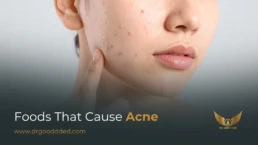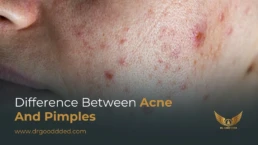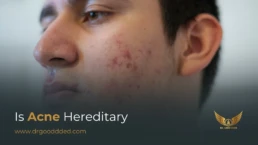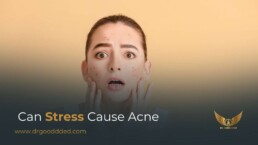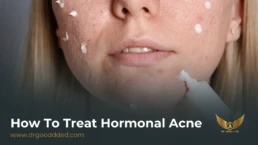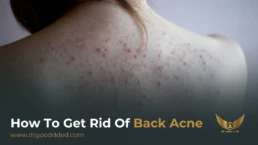Fungal acne is a skin condition caused by the yeast Malassezia. You get many small, uniform, itchy bumps on hair-bearing skin. These bumps are not the same as common bacterial acne. You need different care. If your pimples itch and do not respond to acne medicine, they may be fungal acne.
Table of Contents
ToggleWhat Is Fungal Acne?
Definition And Overview Of Fungal Acne (Malassezia Folliculitis)
Fungal acne is also called Malassezia folliculitis. Malassezia is a yeast that lives on most skin. When it grows too much, it infects hair follicles. This causes small, raised pimples. The pimples often look like tiny red or skin-colored bumps. They appear in clusters. You may also see small pus tips.
How Fungal Acne Differs From Bacterial Acne
The cause is the key difference. Bacterial acne comes from clogged pores and bacteria. Fungal acne comes from yeast. Bacterial acne often has blackheads, whiteheads, and large, inflamed cysts. Fungal acne gives many small, similar bumps. Bacterial acne often does not itch. Itching points more to fungal acne symptoms.
Treatment differs, too. Antibiotics help bacterial acne. Antibiotics do not treat yeast. They can make fungal acne worse. You need antifungal medicine to fix fungal acne.
Why It’s Often Misdiagnosed As Regular Acne
Many people and some clinicians see the bumps and treat them as acne. If the standard acne treatment fails, you often get the wrong medicines for weeks. That delays healing. When the rash is itchy and located on the chest or back, you should suspect fungal acne. A simple test can confirm it.
Fungal Acne Causes
Yeast Overgrowth (Malassezia) And Its Role In Skin Inflammation
Malassezia lives normally on oily skin. It feeds on skin oil. When conditions change, the yeast multiplies. Too much yeast blocks follicles. The blocked follicle then inflames. That inflammation creates the bumps you see as fungal acne. The yeast itself irritates. Redness and itching follow.
Heat, Humidity, And Excessive Sweating As Triggers
Warm and wet skin helps Malassezia grow. You sweat during hot weather or exercise. Sweat stays under clothes that do not breathe. This trapped moisture becomes a nursery for yeast. If you sweat a lot and stay damp, you increase your risk of fungal acne.
Antibiotic Or Steroid Use And Disrupted Skin Microbiome
Antibiotics can change the balance of microbes on the skin. When bacteria drop, yeast faces less competition. This allows yeast to grow more. Topical or oral steroids reduce local immunity. This also helps yeast multiply. Both actions can cause fungal acne to start or flare. That is why doctors warn about long-term antibiotic use for resistant pimples.
Tight Clothing And Friction-Related Breakouts
Friction from tight clothes irritates hair follicles. It also traps sweat close to skin. Friction makes the area more likely to develop yeast overgrowth. You may notice fungal acne where straps, helmets, or tight shirts rub your skin.
Underlying Factors: Weakened Immunity Or Hormonal Imbalance
People with weak immune systems have more skin infections. Hormone changes affect oil production. More oil can feed yeast growth. If you have any chronic illness or take immune-suppressing drugs, your risk of fungal acne grows. Hormones alone do not directly cause the yeast. But they can change the conditions that allow yeast to overgrow.
Fungal Acne Symptoms
Common Signs — Small, Itchy, Uniform Red Bumps
You will see small bumps that all look alike. Most are about the same size. They may be red or a skin color. They often form clusters rather than single pimples. You may feel an itch that is stronger than with regular acne. Itching is a major clue to fungal acne symptoms.
Key Symptom Difference Between Fungal Acne Vs Regular Acne
With bacterial acne, you often find blackheads and a mix of spot sizes. Fungal acne has uniform bumps with no blackheads. Bacterial acne may be tender but rarely intensely itchy. If your spots itch a lot, think fungal acne or regular acne.
Itching And Burning — Unique Fungal Acne Indicators
Itch and a mild burning sensation are common. When you scratch, the area may feel raw. Scratching can worsen the infection. If you feel burning or a strong itch, tell your clinician. These signs guide the right test and treatment.
How Fungal Acne Looks And Feels (Visual Pattern And Texture)
The rash usually appears on hair-rich areas. You may see many tiny pustules or papules. The bumps can be firm to the touch. They rarely form deep cysts. The texture is often rough because many follicles are inflamed. You may notice the bumps under clothing lines.
Fungal Acne Versus Regular Acne
Main Differences In Cause (Yeast Versus Bacteria)
Remember the cause. Yeast causes fungal acne. Bacteria cause common acne. Each disease needs different drugs. Using the wrong drug can slow recovery. If antibiotics failed, consider antifungal therapy.
How Appearance And Distribution Differ
Bacterial acne often affects the face. Fungal acne prefers the upper body. The back, chest, and forehead are common. The distribution helps tell them apart. Uniform clusters on the back often mean fungal acne.
Areas Affected — Fungal Acne On Forehead, Back, And Chest
You often get fungal acne forehead, back, and chest. Helmets and hats trap sweat on the forehead. Shirts and sports gear trap sweat on the back and chest. Those spots stay warm and oily. They then become likely sites for Malassezia growth.
Why Antibiotics Make Fungal Acne Worse
Antibiotics reduce bacteria. That reduces competition for yeast. Yeast then flourishes. The rash can spread after antibiotics. If you notice more bumps after antibiotics, that is a red flag for fungal acne.
Diagnostic Tips: How Doctors Confirm Fungal Acne
A doctor will look at the rash and ask about itch and past treatments. They may scrape the skin for a KOH test. KOH reveals yeast under a microscope. A clear diagnosis avoids repeated wrong treatments. If a clinician suspects fungal acne, they may try a short antifungal trial and watch for rapid improvement.
Diagnosis Of Fungal Acne
Doctors diagnose fungal acne by looking at your skin and asking about symptoms. You will be asked about itch, recent antibiotic use, and where the bumps sit. Your doctor may scrape a few scales. They place the sample on a slide with KOH solution. Under a microscope, they look for yeast. This test confirms Malassezia. A correct test prevents wrong treatments. If the diagnosis is unclear, your doctor may try a short antifungal course and watch for improvement.
Treatment For Fungal Acne
You can treat fungal acne with topical or oral medicines. Mild cases respond to creams and washes. Use medicated cleansers with ketoconazole, selenium sulfide, or zinc pyrithione. Apply these to the affected area and rinse. For many people, this reduces yeast quickly.
If the rash is large or does not clear, your doctor may give oral antifungals. Common choices include fluconazole or itraconazole. Your doctor will pick the right dose and duration. You must follow the prescription exactly.
Avoid using antibiotics or heavy creams on affected areas. Antibiotics can worsen fungal acne. Heavy, oily moisturizers feed yeast. Use light, non-oily products instead. If you have sensitive skin, test products on a small area first.
Over-The-Counter Options
You can buy antifungal washes at stores. Use them as body wash or shampoo for several minutes before rinsing. Common ingredients are ketoconazole and selenium sulfide. These products reduce yeast on the skin. They help clear fungal acne when used correctly.
Prescription Treatments
For stubborn cases, your doctor may prescribe oral antifungal drugs. These clear deep follicle infections faster. You will need monitoring for side effects. Always follow medical advice.
Skincare Do’s And Don’ts
Do:
- Wash after sweating.
- Use antifungal cleansers when advised.
- Wear breathable fabrics.
- Use light, non-oily moisturizers.
Don’t:
- Use topical antibiotics unless needed.
- Apply heavy oils or occlusive products.
- Keep damp clothes on for a long.
Following these rules helps your skin heal faster and avoids relapse of fungal acne.
Fungal Acne On Forehead, Back, And Chest
You often get fungal acne on the upper body. The forehead, back, and chest trap sweat and oil. This makes a good place for yeast to grow. Tight clothing, helmets, and backpacks cause friction and hold moisture. Change sweaty clothes quickly. Use antifungal washes on these areas. For the forehead, avoid heavy hair products that can trap oil near hair follicles.
If you exercise a lot, rinse the skin soon after workouts. Use a ketoconazole shampoo as a body wash on the back and chest two to three times a week. This lowers yeast and helps clear fungal acne forehead.
Home Remedies And Lifestyle Changes
You can reduce flare-ups with simple steps. These actions support medical treatment.
- Shower immediately after workouts. This removes sweat and yeast.
- Wear cotton or moisture-wicking fabrics. These keep skin dry.
- Change out of wet clothes fast. Do not let damp material sit on skin.
- Avoid greasy lotions on problem areas. Use water-based moisturizers if needed.
- Limit sugar and refined carbs where possible. Cutting sugar may help some people reduce yeast growth.
- Use a cool compress if the itch is strong. Do not scratch. Scratching raises infection risk.
These lifestyle steps lower the chance of repeat episodes of fungal acne.
Prevention And Skincare Tips
Prevention helps you avoid a repeat rash. Keep your routine simple and consistent.
- Exfoliate gently once a week to clear dead skin.
- Use antifungal-safe shampoos as body wash when needed.
- Choose sunscreens and moisturizers labeled non-comedogenic.
- Rotate workout clothes and wash them after each use.
- Keep shared towels dry and avoid sharing them.
- Consider a maintenance antifungal wash if you have repeated flares.
These steps help keep Malassezia levels under control. They reduce the chance that fungal acne returns.
When To See A Dermatologist
Visit a dermatologist if your rash:
- Does not improve after two weeks of proper care.
- Spreads widely or causes strong pain or swelling.
- Repeats often despite prevention.
A dermatologist can confirm the diagnosis. They can prescribe oral medicine when needed. They will screen for other causes and make a safe plan.
FAQs
Where Does Fungal Acne Appear Most Commonly?
Fungal acne appears most often on the chest, back, and forehead. These areas trap heat and sweat. The yeast likes oily, warm skin and grows there easily.
Can Fungal Acne Occur On The Face And Back At The Same Time?
Yes, fungal acne can occur on the face and back at once. The yeast can affect multiple areas when conditions are warm and damp, and when you sweat heavily.
Is Fungal Acne Itchy Or Painful?
Fungal acne usually itches more than regular acne. You may feel mild burning. The itch helps tell fungal acne apart from bacterial pimples in many cases.
How Long Does Fungal Acne Take To Clear?
Mild cases clear in weeks with topical treatment. Severe cases may need oral antifungals for several weeks. Follow your doctor’s plan to ensure full recovery.
Can I Treat Fungal Acne At Home Naturally?
You can try antifungal washes and better hygiene at home. Natural remedies lack strong proof. See a doctor if spots persist or spread despite home care.
What Ingredients Help Clear Fungal Acne?
Ketoconazole, selenium sulfide, zinc pyrithione, and oral azoles help clear fungal acne. These ingredients reduce yeast and help follicles heal without heavy oils.
Can Fungal Acne Come Back?
Yes, fungal acne can come back. Heat, sweat, and occlusive products may trigger recurrence. Preventive hygiene and periodic antifungal washes can lower return risk.
Is Fungal Acne Contagious?
Fungal acne is not highly contagious. Shared wet items could spread yeast. Avoid sharing towels and keep items dry to reduce transfer risk.
Does Diet Affect Fungal Acne Flare-Ups?
Diet may play a small role. High sugar intake can feed yeast in some people. A balanced diet and reduced sugar may lower flare-up risk.
Should I Exfoliate When I Have Fungal Acne?
Yes, exfoliate gently. Use mild chemical or physical exfoliation. Overdoing it can irritate the skin and worsen the rash. Keep exfoliation gentle and occasional.

This article is medically reviewed by Dr. Nivedita Pandey, Senior Gastroenterologist and Hepatologist, ensuring accurate and reliable health information.
Dr. Nivedita Pandey is a U.S.-trained gastroenterologist specializing in pre and post-liver transplant care, as well as managing chronic gastrointestinal disorders. Known for her compassionate and patient-centered approach, Dr. Pandey is dedicated to delivering the highest quality of care to each patient.



